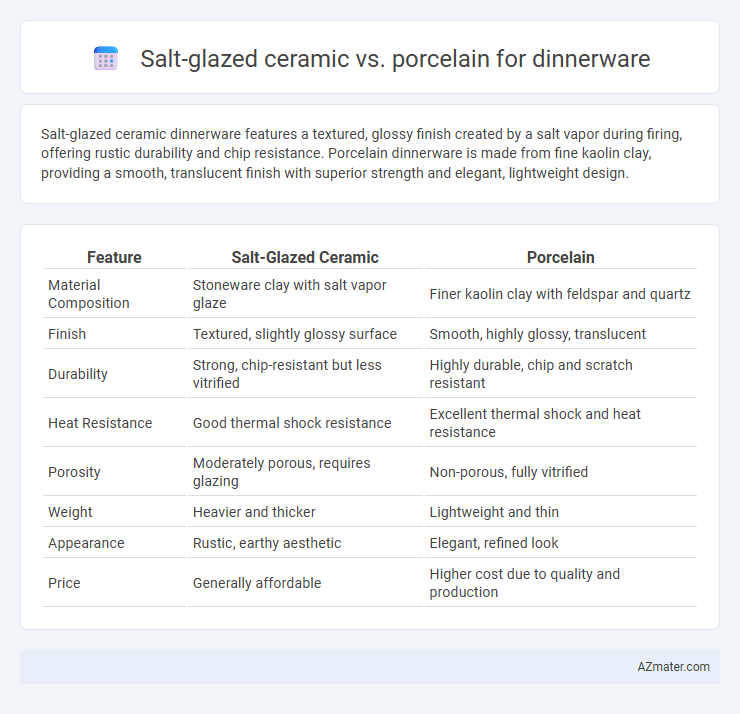Salt-glazed ceramic dinnerware features a textured, glossy finish created by a salt vapor during firing, offering rustic durability and chip resistance. Porcelain dinnerware is made from fine kaolin clay, providing a smooth, translucent finish with superior strength and elegant, lightweight design.
Table of Comparison
| Feature | Salt-Glazed Ceramic | Porcelain |
|---|---|---|
| Material Composition | Stoneware clay with salt vapor glaze | Finer kaolin clay with feldspar and quartz |
| Finish | Textured, slightly glossy surface | Smooth, highly glossy, translucent |
| Durability | Strong, chip-resistant but less vitrified | Highly durable, chip and scratch resistant |
| Heat Resistance | Good thermal shock resistance | Excellent thermal shock and heat resistance |
| Porosity | Moderately porous, requires glazing | Non-porous, fully vitrified |
| Weight | Heavier and thicker | Lightweight and thin |
| Appearance | Rustic, earthy aesthetic | Elegant, refined look |
| Price | Generally affordable | Higher cost due to quality and production |
Introduction to Salt-glazed Ceramic and Porcelain
Salt-glazed ceramic dinnerware features a distinctive glossy, textured surface created by vaporizing salt during the kiln firing process, which forms a durable, glass-like coating. Porcelain dinnerware is crafted from refined clay fired at extremely high temperatures, resulting in a smooth, translucent, and highly durable material prized for its strength and elegant finish. Both materials offer unique benefits, with salt-glazed ceramics providing rustic charm and porcelain delivering a refined and sophisticated aesthetic ideal for formal dining.
Historical Background and Origins
Salt-glazed ceramics originated in 15th-century Germany, where potters introduced salt into kilns at high temperatures, creating a distinctive glossy, textured surface valued for its durability and rustic aesthetic. Porcelain, developed during the Tang Dynasty in China around the 7th century and perfected in the Song Dynasty, became renowned for its strength, translucency, and fine, smooth finish due to its high kaolin clay content and advanced firing techniques. Both materials reflect deep cultural histories and technological innovations that greatly influenced dinnerware traditions worldwide.
Material Composition and Manufacturing Process
Salt-glazed ceramic dinnerware features a unique surface created by throwing salt into a hot kiln, which reacts with the silica in the clay body to form a glassy, textured finish, typically made from stoneware clay rich in alumina and silica. Porcelain dinnerware is composed primarily of kaolin clay, feldspar, and quartz, fired at extremely high temperatures above 1300degC to achieve a dense, non-porous, and translucent quality. The manufacturing process of salt-glazed ceramics results in a durable but slightly rough surface ideal for rustic aesthetics, while porcelain's vitrification creates a smooth, elegant, and highly durable finish favored for fine dining.
Appearance and Surface Texture
Salt-glazed ceramics exhibit a distinctive, slightly glossy surface with a textured, orange-peel effect resulting from the vaporized salt reacting with the clay during firing, offering a rustic and organic aesthetic. Porcelain dinnerware features a smooth, glass-like, and highly polished surface with a pristine white or translucent quality, emphasizing elegance and refined craftsmanship. The tactile contrast between the rougher, matte feel of salt-glazed ceramics and the sleek, cool touch of porcelain highlights their unique visual and sensory appeal.
Durability and Strength Comparison
Salt-glazed ceramics exhibit a dense, glassy surface formed by salt vapor during firing, enhancing their resistance to chipping and scratching, which makes them highly durable for daily use. Porcelain, composed of kaolin clay and fired at higher temperatures, offers superior strength, a vitrified texture, and exceptional chip resistance, allowing it to withstand heavy use and frequent washing. While both materials provide strong dinnerware options, porcelain typically outperforms salt-glazed ceramics in strength and long-term durability due to its finer, more compact microstructure.
Porosity and Stain Resistance
Salt-glazed ceramics have a higher porosity compared to porcelain, making them more susceptible to absorbing liquids and stains over time. Porcelain features a dense, vitrified surface that significantly reduces porosity and enhances stain resistance, providing greater durability and ease of maintenance for dinnerware. This low porosity in porcelain prevents moisture penetration and discoloration, ensuring a longer-lasting, pristine appearance.
Heat and Thermal Shock Resistance
Salt-glazed ceramic dinnerware offers excellent heat resistance with a durable, glass-like surface formed by the salt firing process, making it suitable for high-temperature use. Porcelain boasts superior thermal shock resistance due to its dense, vitrified structure, allowing it to withstand rapid temperature changes without cracking. When choosing dinnerware, porcelain provides greater reliability in scenarios involving temperature fluctuations, while salt-glazed ceramics excel in heat retention during oven-to-table service.
Safety, Food Compatibility, and Lead Content
Salt-glazed ceramic dinnerware is generally less porous and more resistant to stains but may contain higher levels of lead if not properly manufactured, posing potential safety risks. Porcelain is typically non-porous, highly durable, and often certified lead-free, making it a safer choice for food compatibility and long-term use. Both materials require verification of lead content and food-safe certification to ensure safe dining applications.
Design Versatility and Aesthetic Options
Salt-glazed ceramic offers a distinctive textured finish with natural earth tones, providing a rustic and artisanal aesthetic that appeals to those seeking unique, handcrafted dinnerware. Porcelain stands out for its sleek, smooth surface and translucency, allowing for a wide range of colors, patterns, and intricate designs that cater to elegant and modern table settings. The design versatility of salt-glazed ceramic suits casual and organic dining atmospheres, while porcelain excels in delivering refined aesthetics and customizable decorative options for formal occasions.
Price Range and Value for Money
Salt-glazed ceramic dinnerware typically falls within a moderate price range, offering unique textured finishes and durability that appeal to artisanal collectors and everyday users alike. Porcelain, however, commands a higher price due to its refined appearance, translucency, and exceptional strength, making it a valued investment for formal dining and long-term use. When considering value for money, salt-glazed ceramics provide cost-effective artistry and resilience, whereas porcelain delivers enhanced elegance and longevity that justify its premium cost.

Infographic: Salt-glazed ceramic vs Porcelain for Dinnerware
 azmater.com
azmater.com